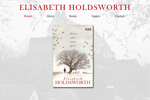 I’ve been able to launch another new client site, this one for Australian writer Elisabeth Holdsworth.
I’ve been able to launch another new client site, this one for Australian writer Elisabeth Holdsworth.
Elisabeth is an essayist and reviewer who has just published her first novel, Those Who Come After.
The book is based on and extrapolated from Elisabeth’s own experiences, which she previously covered in an essay that won the inaugural Calibre Prize in 2007.
It might sound like overkill – writing a novel based on your own essay about your own upbringing – but Elisabeth’s is quite a story.
The following extract is from another essay of hers, Missing from my own life, published in 2008.
My full name is Elisabeth Miriam Esther de Rijke-Nassau. I am a medieval dinosaur. When I die, a DNA coiling back to Charlemagne will be declared extinct. In 2010 others who claim a more indirect descent from Charlemagne will gather in a place called Vianden, in Luxemburg, to celebrate one thousand years of identity as the Nassaus. Vianden, a castle in the air, was abandoned in the seventeenth century but reconstructed in the 1960s. It is where my ancestors first established their identities as warlords, dukes and princes. Now it is a tourist site.
The Nassaus led the revolt of the Low Countries against the Spanish in a war that lasted the worst part of eighty years, ending in 1588. A century later, another Nassau, William of Oranje-Nassau, became king of England. At the Battle of the Boyne he defeated his father-in-law, James II, the last Catholic king of the English. Among William’s legacies was a divided Ireland and the wearing of the Orange in support of the Protestant cause.
I was born on a freezing day in January 1947 in a place called Middelburg, on the island of Walcheren, the most south-western province of the Netherlands. Middelburg, or Middelbroch as it was known in the Middle Ages, was founded in the twelfth century by Elisabeth Kunigunda, daughter of the king of Thuringia and wife of Wolfert of Nassau. My grandfather, who had many titles but preferred to be known as ‘The Lord of the Islands’, registered my birth the same day. As if he knew I would be the dynasty’s full stop, he added to my birth certificate the title ‘The Lady of the Islands’. The matter of titles is a minefield of arcane conundrums. Only someone born into the family can be known as the Lord of the Islands. As I come from an unbroken male line, there had never been a ‘Lady’ before.
A few days after my birth, I was decked out in eighteenth century lace in preparation for my baptism. The tradition of the Calvinist sect I was born into dictates that one of the godparents should carry the child to church. My godfather, Prince Bernhard, the German-born son-in-law of Queen Wilhelmina – a war hero like my father, who was his close friend – emerged from my grandparents’ house, took one look at the snow and ice in the street and removed his army greatcoat. I was carried to my baptism wrapped in the same coat that Prince Bernhard had worn when he accepted the German surrender at Wageningen.
This should tell you two things: Elisabeth has quite a story to tell, and the telling of it plays a large part in her life.
I suppose this is all the more pertinent for me, because I’m Dutch-born myself. It certainly never occurred to me that when I sang the words of the Dutch national anthem as a child that I would later build a website for a descendant of the king mentioned in the song’s opening lyric.
As an immigrant, there is a further level of interest for me in Elisabeth’s story, in that it is very different to my own. My working class parents emigrated to Australia with the specific aim of providing greater educational, social and career opportunities than might have been available in The Netherlands. The Holdsworth family had very different reasons for emigrating and lived in very different circumstances.
The website itself is not a complex one, but that didn’t make it any easier to create. I think quite a few designers are like me and find sites with lots of content rather easier to build than those that only have a few pages. On a small site, every page seems to carry greater value.
In this case, I have probably ended up placing more emphasis on style, look and feel than I might normally. And there is also a kind of freedom in that.
By the way, the castle in the background of each page is the one Elisabeth refers to in the excerpt above. The presence of this edifice is intended to serve as a visual metaphor for the looming sense of historical imperative that pervades Elisabeth’s writing.